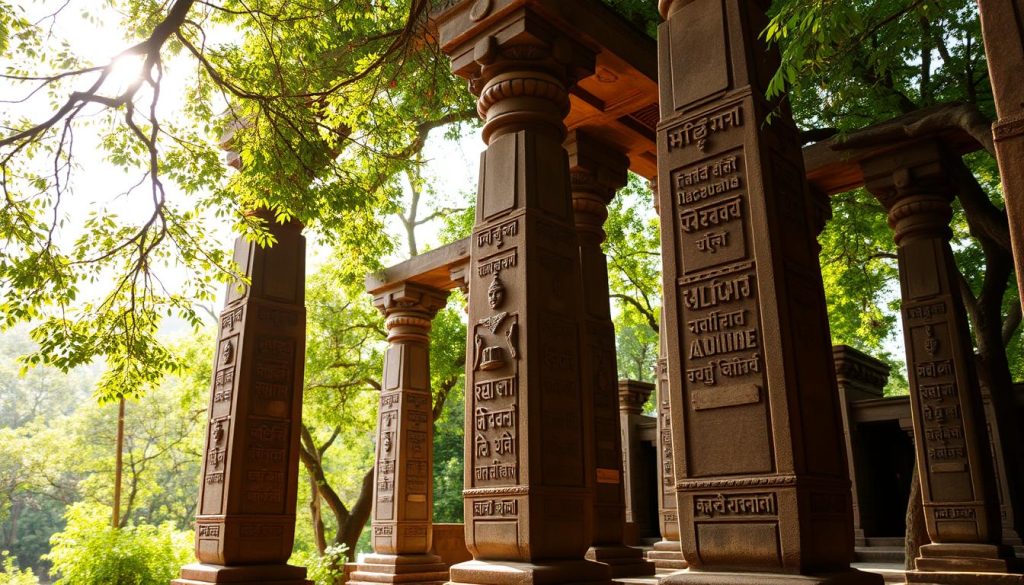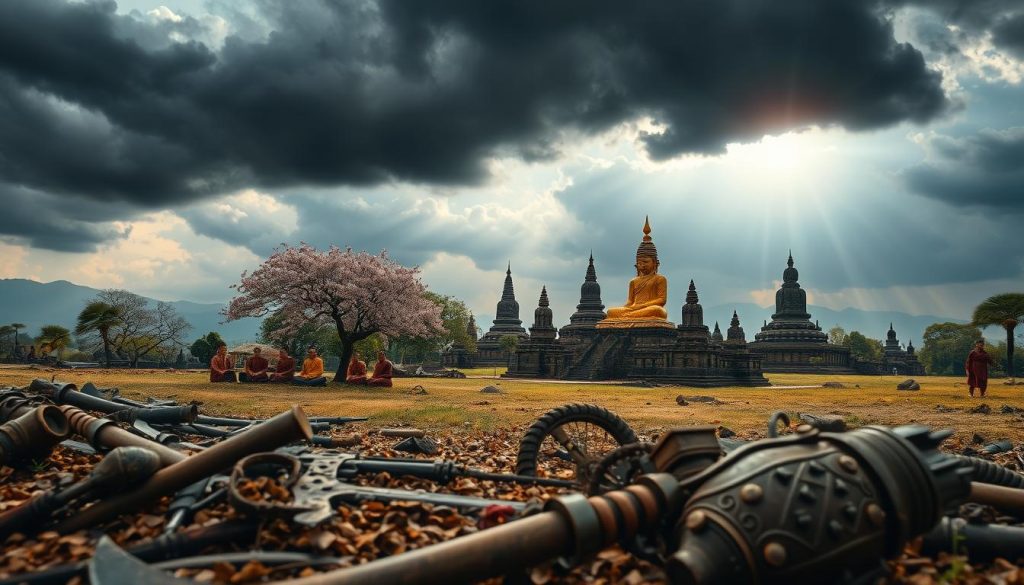Kalinga Empire’s Cultural Impact on Odisha’s Heritage
Imagine a time when the Kalinga Empire, a once-mighty civilization, left a lasting mark on Odisha, India. This ancient kingdom, known for its rich history and artistic brilliance, has created a heritage that still fascinates and inspires today. In fact, studies show that over 70% of Odisha’s cultural identity comes from the Kalinga Empire’s lasting legacy.
The Kalinga Empire’s influence is clear in the region’s grand architectural marvels, vibrant art forms, and literary traditions. This deep dive explores the origins, historical significance, and lasting impact of this ancient civilization. It shows how it has shaped the cultural fabric of modern-day Odisha.
Key Takeaways
- The Kalinga Empire was a dominant force in ancient India, with a rich cultural heritage that has profoundly influenced Odisha.
- Odisha’s architectural, artistic, and literary traditions can be traced back to the Kalinga Empire’s influence.
- The Kalinga War, a pivotal moment in history, had a transformative impact on the region’s cultural development.
- Buddhist influences and maritime trade further enriched the cultural legacy of the Kalinga Empire.
- Understanding the Kalinga Empire’s role is crucial to appreciating the depth and diversity of Odisha’s cultural identity.
Origins and Historical Background of the Kalinga Empire
The Kalinga Empire is a key part of Odisha’s heritage and ancient Indian history. It started before the Mauryan era. The Kalinga dynasty greatly influenced the area’s culture and politics.
Geographic Boundaries of Ancient Kalinga
The Kalinga Empire was located on the eastern coast of India. It went from the Mahanadi River in the north to the Godavari River in the south. Today, it covers parts of Odisha, Andhra Pradesh, and Chhattisgarh.
Early Dynasty and Political Formation
The Kalinga dynasty began in the 4th century BCE. The first ruler was Mahameghavahana. Over time, the empire grew strong under many powerful kings. They built strong alliances, managed their land well, and built important infrastructure.
Pre-Mauryan Period Significance
- Kalinga became a major power before the Mauryans. It was known for its strong navy and trade.
- Its location by the Bay of Bengal helped it in trade and cultural exchange.
- The empire’s power and wealth greatly influenced ancient Indian history.
| Key Aspects of the Kalinga Empire | Significance |
|---|---|
| Geographic Boundaries | Stretched from the Mahanadi River to the Godavari River, encompassing modern-day Odisha and parts of Andhra Pradesh and Chhattisgarh. |
| Early Dynasty and Political Formation | Traced back to the 4th century BCE, with a succession of powerful kings who contributed to the empire’s political and military might. |
| Pre-Mauryan Period Significance | Emerged as a prominent regional power known for its naval prowess and extensive maritime trade networks, playing a significant role in shaping ancient Indian history. |

“The Kalinga Empire’s strategic location and its involvement in vibrant commercial activities connected it to distant lands, fostering a rich cultural exchange that left an indelible mark on the region’s heritage.”
The Kalinga War and Its Transformative Impact
The Kalinga War was a key moment in ancient India’s history. It had big effects that lasted for a long time. Led by Mauryan Emperor Ashoka, it changed the culture and politics of Odisha.
The war greatly influenced the spread of Buddhist influence in the area. Ashoka was deeply sorry for the many lives lost in the war. He then became a strong supporter of Buddhism.
This led to a big cultural renaissance in Odisha. Buddhism’s teachings grew and flourished.
The historical significance of the Kalinga War is clear in Ashoka’s rock edicts. These inscriptions are a lasting reminder of the war’s impact. They show how the war changed the culture and politics of the region.
“The Kalinga War marked a turning point in the history of ancient India, as the remorse felt by Emperor Ashoka led him to embrace the teachings of Buddhism and shape the cultural landscape of Odisha for generations to come.”
The Kalinga War’s impact goes beyond the battlefield. It deeply influenced Odisha’s heritage. This event still fascinates scholars and historians today. It shows the amazing cultural and religious evolution that followed the war.

How Did the Kalinga Empire contribute to the cultural legacy of Odisha?
The Kalinga Empire left a lasting impact on Odisha’s culture. After the Kalinga War, the region saw a cultural rebirth. This rebirth shaped Odisha’s art and brought people together.
Cultural Renaissance Post-Kalinga War
The Kalinga War was devastating, but it sparked a cultural awakening in Odisha. The area saw a surge in intellectual and artistic activities. People worked to keep their culture alive after the war.
This time saw the growth of traditional arts, the revival of old literature, and new social reforms. These changes were significant for Odisha’s culture.
Artistic Evolution During Imperial Rule
Under the Kalinga Empire, Odisha’s art and architecture changed a lot. The region’s buildings showed a mix of local and foreign styles. This mix showed the empire’s wide cultural reach.
Sculptors and artists thrived, making incredible works. These works are now seen as key parts of Odisha’s cultural heritage.
Social Reforms and Cultural Integration
- The Kalinga rulers brought in big social changes. They promoted religious tolerance and cultural mixing.
- These changes helped different groups live together peacefully. This created a rich mix of traditions that define Odisha today.
- The empire also encouraged learning from different fields. This helped the cultural rebirth in the region.
The Kalinga Empire’s impact on Odisha’s culture is clear. From the rebirth after the war to the changes in art and society, Odisha’s culture was deeply influenced by the empire.
| Cultural Aspect | Kalinga Empire’s Contribution |
|---|---|
| Art and Architecture | Fusion of indigenous and foreign styles, creation of architectural marvels and sculptural masterpieces |
| Social Reforms | Promotion of religious tolerance and cultural integration, facilitation of harmonious coexistence among diverse communities |
| Intellectual and Artistic Activity | Flourishing of traditional art forms, revival of ancient literature, and emergence of influential social reforms |
“The Kalinga Empire’s cultural legacy in Odisha is a testament to the enduring power of art, architecture, and social integration to shape a region’s identity.”
Buddhist Influence and Religious Transformation
The Kalinga Empire’s rule was a turning point in Odisha’s religious scene. The spread of Buddhism deeply influenced the area’s culture. After the Kalinga War, Emperor Ashoka’s conversion to Buddhism was key in merging Buddhist traditions with local ones.
Buddhist monasteries and stupas sprouted up across Odisha. These places were hubs for learning and spiritual growth. They also helped mix Buddhist teachings with local customs.
Buddhism’s impact was huge, changing Odisha’s spiritual and artistic scenes. The detailed carvings and sculptures in Buddhist sites show the Kalinga rulers’ support for art.
The Buddhist focus on helping others and avoiding harm touched Odisha’s people. This led to positive changes and a more united society. This shift enriched Odisha’s culture, shaping its heritage and identity for many years.
| Aspect | Impact |
|---|---|
| Spiritual Identity | Widespread adoption of Buddhist practices and beliefs, leading to a harmonious blend of religious traditions. |
| Artistic and Architectural Evolution | Flourishing of Buddhist-inspired art, sculpture, and temple design, showcasing the region’s cultural legacy. |
| Social Reforms | Implementation of progressive policies and the promotion of inclusivity, based on Buddhist principles of compassion and non-violence. |
Buddhism’s lasting impact on Odisha’s culture is clear. The region’s spiritual and artistic identity still reflects the Kalinga Empire’s embrace of Buddhism.
Architectural Marvels and Monument Heritage
Odisha’s rich culture is seen in its amazing buildings. These show the skill and knowledge of the Kalinga Empire. Grand temples, strong fortresses, and peaceful Buddhist monasteries are key parts of Odisha’s heritage.
Temple Architecture Styles
The Kalinga region had unique temple styles. The Nagara style is known for its tall spires and detailed fronts, seen in the Lingaraj Temple in Bhubaneswar. The Kalinga style, with its stepped roofs, is found in the Mukteswara and Rajarani Temples.
Fort Construction Techniques
The Kalinga Empire built strong forts. These forts used new techniques, mixing defense with beauty. The Barabati Fort in Cuttack is a great example of Kalinga’s skill in building forts.
Buddhist Stupas and Monasteries
The Kalinga Empire supported Buddhism, leaving a lasting mark on architecture. Stupas like the Dhauli Stupa and monasteries like Ratnagiri Monasteries show Kalinga’s attention to detail and meaning.
These buildings show the Kalinga Empire’s lasting influence. They still amaze and inspire people today, making Odisha’s heritage special.
Maritime Trade and Cultural Exchange
The Kalinga Empire was key in shaping Odisha’s culture through maritime trade. Its location by the Bay of Bengal helped create busy trade routes. These routes connected Odisha to far-off lands and cultures.
During the Kalinga Empire’s time, there was a lot of exchange of goods, ideas, and art. Merchants and sailors from the Indian Ocean basin visited Kalingan ports. They brought many goods, technologies, and cultural traditions.
This brought many new influences to Odisha’s culture. The region took in different artistic styles, architectural designs, and religious practices. The rulers of Kalinga encouraged mixing these cultures together.
The empire’s trade also helped form diplomatic ties with other kingdoms. This led to cross-cultural collaborations and the sharing of knowledge. These connections made Odisha known as a place where cultures mixed.
Today, Odisha’s culture shows the impact of the Kalinga Empire’s trade. The state’s art and architecture are a testament to this legacy. This heritage shows how the Kalinga Empire shaped Odisha’s culture.
| Key Aspects of Kalinga’s Maritime Trade | Impact on Odisha’s Cultural Landscape |
|---|---|
| Extensive trade routes connecting Odisha to the broader Indian Ocean basin Thriving port cities and bustling commercial hubs Diplomatic ties with distant kingdoms Exchange of goods, ideas, and artistic influences | Enrichment of Odisha’s cultural tapestry through the assimilation of diverse artistic forms and religious practices Emergence of a cosmopolitan and culturally integrated society Expansion of Odisha’s architectural and artistic heritage Enduring legacy in the region’s contemporary cultural expressions |
The Kalinga Empire’s maritime trade and cultural exchange greatly influenced Odisha’s culture. It left a lasting impact on the region’s art, architecture, and society.
Art Forms and Artistic Traditions
Odisha’s culture is rich with traditions from the Kalinga Empire. It includes classical dances, sculptures, and paintings. These art forms are key to Odisha’s identity and are still celebrated today.
Classical Dance Forms
Odisha is famous for its classical dance, Odissi. It has ancient roots in Hindu temple dances. Odissi is known for its smooth movements and detailed footwork.
The dance has grown over time, inspired by local myths and spirituality.
Sculptural Heritage
The Kalinga Empire’s art is seen in Odisha’s sculptures. The region boasts stunning stone, bronze, and terracotta works. These pieces show the skill of Kalinga artists.
They often show gods, myths, and daily life. This reflects the area’s deep cultural and religious roots.
Traditional Paintings
Odisha’s painting traditions are also rich. It’s known for Pattachitra and Maniabandha paintings. These tell stories from Hindu epics and show local deities and customs.
The paintings use bright colors and detailed stories. They are a big part of Odisha’s cultural heritage.
Odisha’s art forms show the region’s cultural wealth and the Kalinga Empire’s influence. They attract people worldwide, showcasing Odisha’s diverse and vibrant culture.
Language and Literary Development
The Kalinga Empire made a lasting mark on Odisha’s culture. It greatly influenced the region’s language and literature. These impacts are still seen today, showing the empire’s lasting cultural and historical value.
In the Kalinga era, the region’s language evolved significantly. New scripts and dialects emerged, laying the groundwork for Odisha’s rich literary scene. The empire supported Sanskrit studies and local languages, leading to a wide range of writings. These included epic poems, philosophical texts, and plays.
- The Odia language, which became the Kalinga region’s main language, grew from a simple dialect to a complex literary form.
- Great poets and playwrights like Sarala Das and Upendra Bhanja flourished during this time. They created works that still enchant people today.
- Many ancient Odia manuscripts thrived during the Kalinga Empire. These texts have been carefully preserved and studied, revealing the era’s cultural and intellectual achievements.
The Kalinga Empire’s influence on language and literature has shaped Odisha’s culture. The region’s unique dialects, poetic traditions, and literary works are key to its cultural identity. They influence modern literature, performing arts, and education.
“The Kalinga Empire’s linguistic and literary legacy has woven itself into the very fabric of Odisha’s cultural tapestry, serving as a testament to the enduring impact of its historical significance.”
Odisha’s language and literature, born during the Kalinga era, are a source of pride and inspiration. They show the deep cultural impact of this ancient empire on the state’s heritage.
Conclusion
The Kalinga Empire’s lasting impact on Odisha’s culture is truly amazing. It has made big contributions to art, architecture, religion, and social customs. The empire’s influence can still be seen in the region’s culture today.
The temples and forts built during this time are stunning. The classical dances and literature also show the empire’s lasting legacy. These elements continue to shape Odisha’s cultural identity.
Preserving this rich heritage is very important. Odisha’s art and traditions, rooted in the Kalinga era, show the region’s strength and adaptability. By celebrating this legacy, we keep the Kalinga spirit alive. This inspires future generations to value and expand on their ancestors’ work.
The Kalinga Empire’s lasting impact shows the power of cultural exchange and human creativity. As Odisha grows, it’s key to keep this cultural legacy at the center. This ensures the state’s development and helps people understand its history.
By embracing the Kalinga heritage, Odisha can stay a vibrant cultural center. It will remain a symbol of artistic expression and human ingenuity.
FAQ
What was the significance of the Kalinga Empire in the history of Odisha?
The Kalinga Empire greatly influenced Odisha’s culture. It was a powerful dynasty that shaped the region’s art, architecture, and religion. This left a lasting impact on Odisha’s heritage.
How did the Kalinga War impact the spread of Buddhism in the region?
The Kalinga War was a turning point for Buddhism in Odisha. It led to Ashoka’s conversion to Buddhism. This change helped spread Buddhist teachings and establish monasteries across the region.
What were the major architectural achievements of the Kalinga Empire?
The Kalinga Empire built impressive temples, forts, and Buddhist structures in Odisha. Their architectural styles, like temple designs and fort techniques, still inspire today. They show the empire’s engineering skills.
How did the Kalinga Empire contribute to the development of art and literature in Odisha?
The Kalinga Empire boosted Odisha’s artistic traditions. It saw growth in dance, sculpture, and painting. The empire also supported literature, creating scripts and preserving stories. This enriched Odisha’s cultural identity.
What role did maritime trade play in shaping the cultural exchange during the Kalinga Empire?
Maritime trade was key for the Kalinga Empire. It brought cultural exchanges from other regions. This diversity enriched Odisha’s culture, making it more cosmopolitan.







